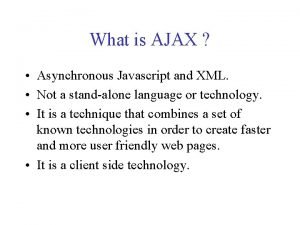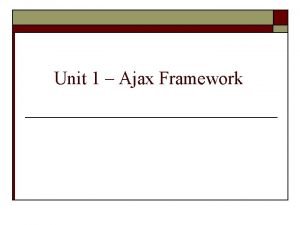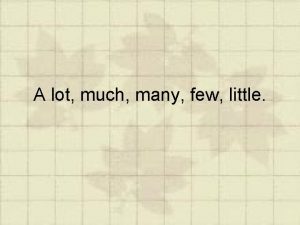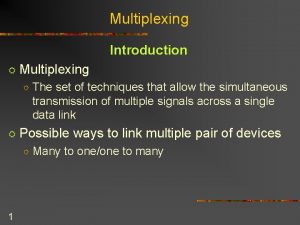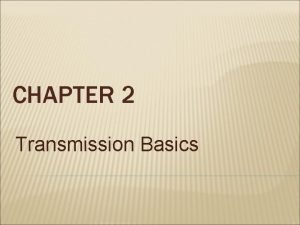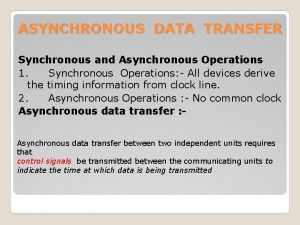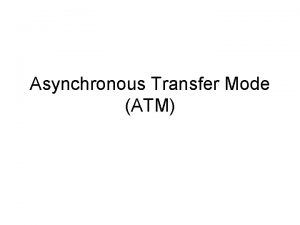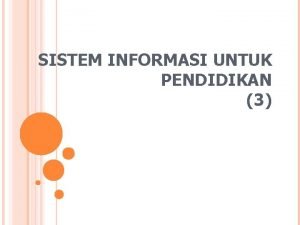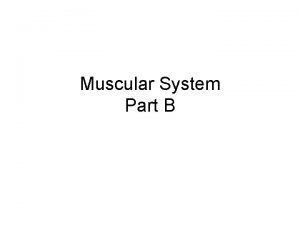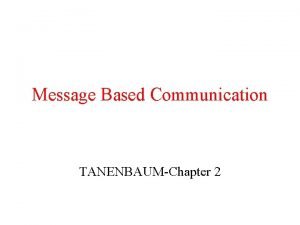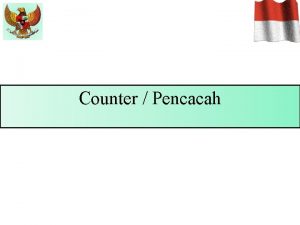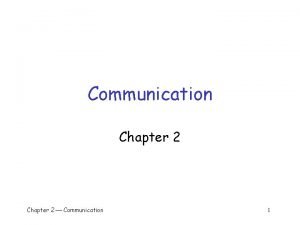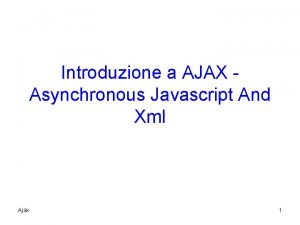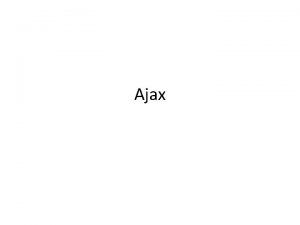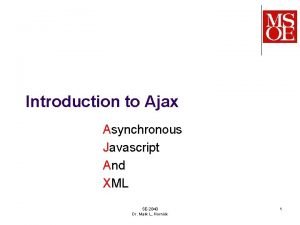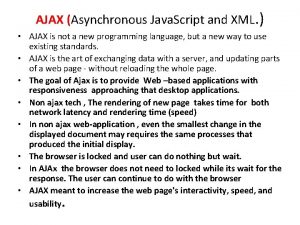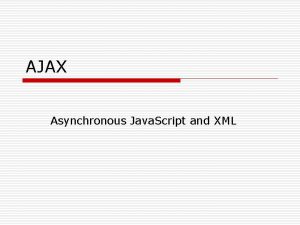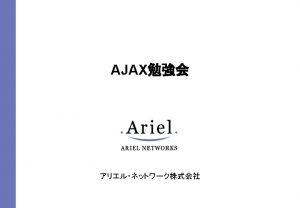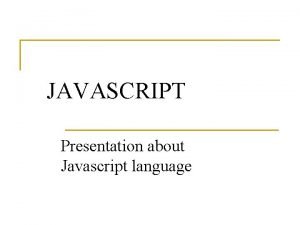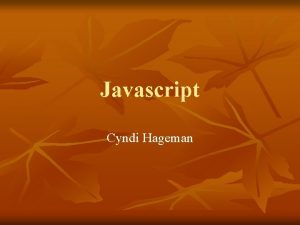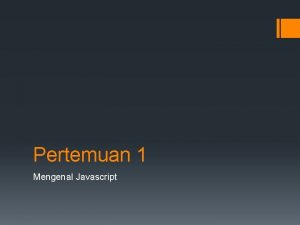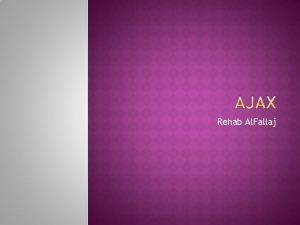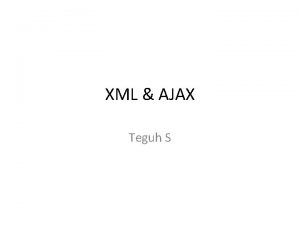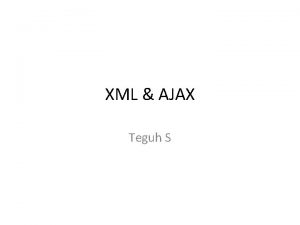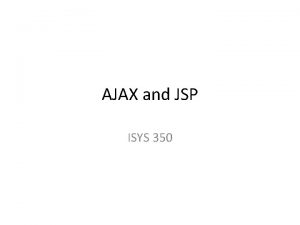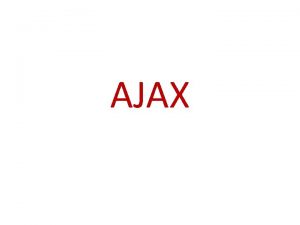AJAX Asynchronous Javascript And XML AJAX A lot





















![AJAX in JQuery • Simplified • $. ajax(url, [settings]) – url : a string AJAX in JQuery • Simplified • $. ajax(url, [settings]) – url : a string](https://slidetodoc.com/presentation_image_h/200acacfd63bda280f52122d2e72dad3/image-22.jpg)


![AJAX in JQuery • $. get(url [, data] [, success(data, text. Status, jq. XHR){} AJAX in JQuery • $. get(url [, data] [, success(data, text. Status, jq. XHR){}](https://slidetodoc.com/presentation_image_h/200acacfd63bda280f52122d2e72dad3/image-25.jpg)

![Ajax show_product. php <? php $id = $_POST['id']; Get this from the Ajax call Ajax show_product. php <? php $id = $_POST['id']; Get this from the Ajax call](https://slidetodoc.com/presentation_image_h/200acacfd63bda280f52122d2e72dad3/image-27.jpg)

- Slides: 28

AJAX Asynchronous Javascript And XML

AJAX • A lot of hype – It has been around for a while – Not complex • Powerful approach to building websites – Think differently • Allows for more interactive web applications – Gmail, docs. google. com, Flickr, ajax 13, etc.



ONE SHAKE PLEASE

AJAX Technologies • HTML – Used to build web forms and identify fields • Javascript – Facilitates asynchronous communication and modification of HTML in-place • DHTML - Dynamic HTML – Additional markup for modifying and updating HTML • DOM - Document Object Model – Used via Javascript to work with both the structure of your HTML and also XML from the server

The XMLHttp. Request Object • Base object for AJAX – Used to make connections, send data, receive data, etc. • Allows your javascript code to talk back and forth with the server all it wants to, without the user really knowing what is going on. • Available in most browsers – But called different things

The XMLHttp. Request Object �script language="javascript" type="text/javascript"> < var request; function create. Request() { try { request = new XMLHttp. Request(); if (request. override. Mime. Type) { request. override. Mime. Type('text/xml'); } } catch (trymicrosoft) { try { request = new Active. XObject("Msxml 2. XMLHTTP"); } catch (othermicrosoft) { try { request = new Active. XObject("Microsoft. XMLHTTP"); } catch (failed) { request = false; } } } if (!request) alert("Error initializing XMLHttp. Request!"); } </script>

Communicating • Steps – – – Gather information (possibly from HTML form) Set up the URL Open the connection Set a callback method Send the request function get. Customer. Info() { var phone = document. get. Element. By. Id("phone"). value; var url = "/cgi-local/lookup. Customer. php? phone=" + escape(phone); request. open("GET", url, true); request. onreadystatechange = update. Page; request. send(null); }

Handling Server Responses • When the server responds, your callback method will be invoked. – It is called at various stages of the process – Test ready. State function update. Page() { if (request. ready. State == 4) { if (request. status == 200) { // Handle the response } else alert("status is " + request. status); } }

HTTP Ready States • 0: The request is uninitialized – Before calling open() • 1: The request is set up, but hasn’t been sent – Before calling send() • 2: The request is sent and is being processed – Sometimes you can get content headers now • 3: The request is being processed – The server hasn’t finished with its response • 4: The response is complete

The XMLHttp. Request Object • Methods – abort() • cancel current request – get. All. Response. Headers() • Returns the complete set of http headers as a string – get. Response. Header(“headername”) • Return the value of the specified header – open(“method”, “URL”, async, “uname”, “passwd”) • Sets up the call – set. Request. Header(“label”, “value”) – send(content) • Actually sends the request

The XMLHttp. Request Object • Properties – onreadystatechange • Event handler for an event that fires at every state change – ready. State • Returns the state of the object – response. Text • Returns the response as a string – response. XML • Returns the response as XML - use W 3 C DOM methods – status • Returns the status as a number - ie. 404 for “Not Found” – status. Text • Returns the status as a string - ie. “Not Found”

Typical AJAX Flow • Make the call – – – Gather information (possibly from HTML form) Set up the URL Open the connection Set a callback method Send the request • Handle the response (in callback method) – When request. ready. State == 4 and request. status == 200 – Get the response in either text or xml • request. response. Text or request. response. XML – Process the response appropriately for viewing – Get the objects on the page that will change • document. get. Element. By. Id or document. get. Element. By. Name, etc. – Make the changes


AJAX Response Handler function update. Page() { if (request. ready. State == 4) { if (request. status == 200) { var response = request. response. Text. split("|"); // “order|address” document. get. Element. By. Id("order"). value = response[0]; document. get. Element. By. Id("address"). inner. HTML = response[1]; } else alert("status is " + request. status); } }

Simple AJAX Example • Enter username • If you have been to the site before – Say welcome back • Else – Say nice to meet you – Enter into list (perhaps) • ajaxform. html, ajax. js, ajax. php – http: //dna. cs. byu. edu/~snell/Classes/CS 360/simpleajax/ajaxform. html

function load. Map(filename) // Download the data in data. xml and load it on the map. The format we expect is: { // <markers> // <marker lat="37. 441" lng="-122. 141" note="marker notes"/> var request = GXml. Http. create(); // <marker lat="37. 322" lng="-121. 213" note="marker notes"/> request. open("GET", filename, true); // </markers> request. onreadystatechange = function() // <trail> // <point lat="37. 441" lng="-122. 141"/> { // <point lat="37. 322" lng="-121. 213"/> if (request. ready. State == 4) // </trail> { var xml. Doc = request. response. XML; var markers = xml. Doc. document. Element. get. Elements. By. Tag. Name("marker"); mapmarkers. length=0; for (var i = 0; i < markers. length; i++) { mapmarkers. push(create. Marker(new GLat. Lng(parse. Float(markers[i]. get. Attribute("lat")), parse. Float(marke map. add. Overlay(mapmarkers[i]); } map. set. Center(new GLat. Lng(parse. Float(markers[0]. get. Attribute("lat")), parse. Float(markers[0]. get. Attribute("lng mappoints. length = 0; var trailpoints = xml. Doc. document. Element. get. Elements. By. Tag. Name("point"); for (var i = 0; i < trailpoints. length; i++) { var tpoint = new GLat. Lng(parse. Float(trailpoints[i]. get. Attribute("lat")), parse. Float(trailpoints[i]. get. Attribute mappoints. push(tpoint); } map. add. Overlay(new GPolyline(mappoints)); } } request. send(null); }

AJAX Libraries • Prototype – http: //www. prototypejs. org/ • Scriptaculous – http: //script. aculo. us/ • JQuery – http: //jquery. com/ • Mochikit – http: //mochikit. com/

Prototype Sample new Ajax. Request('/some_url', { method: 'get', on. Success: function(transport) { var response = transport. response. Text || "no response text"; alert("Success! nn" + response); }, on. Failure: function() { alert('Something went wrong. . . ') } });

Prototype Example <html> <head> <title>Testing Prototype</title> <script src="http: //www. prototypejs. org/assets/2008/9/29/prototype-1. 6. 0. 3. js"></script> <script> function get. Products() { new Ajax. Updater('products', 'products. html', { method: 'get' }); } </script> </head> <body> <h 2>Our fantastic products</h 2> <div id="products"><a href = "#" on. Click="get. Products(); ">(fetch product list. . . )</a></div> </body> </html>
![AJAX in JQuery Simplified ajaxurl settings url a string AJAX in JQuery • Simplified • $. ajax(url, [settings]) – url : a string](https://slidetodoc.com/presentation_image_h/200acacfd63bda280f52122d2e72dad3/image-22.jpg)
AJAX in JQuery • Simplified • $. ajax(url, [settings]) – url : a string containing the url - optional – settings : key-value pairs – Returns jq. XHR object (superset of XMLHTTPRequest object) • Example: $. ajax({ type: "POST", url: "some. php", data: { name: "John", location: "Boston" } });

The jq. XHR Object • Superset of the XMLHTTPRequest • Contains response. Text and response. XML properties and get. Response. Header() method • Other functions – jq. XHR. done(function(data, text. Status, jq. XHR){} ) – jq. XHR. fail(function(jq. XHR, text. Status, error. Thrown){} ) – jq. XHR. always(function(data, text. Status, error){} )

AJAX & the jq. XHR Object var jqxhr = $. ajax( "example. php" ). done(function() { alert( "success" ); }). fail(function() { alert( "error" ); }). always(function() { alert( "complete" ); });
![AJAX in JQuery geturl data successdata text Status jq XHR AJAX in JQuery • $. get(url [, data] [, success(data, text. Status, jq. XHR){}](https://slidetodoc.com/presentation_image_h/200acacfd63bda280f52122d2e72dad3/image-25.jpg)
AJAX in JQuery • $. get(url [, data] [, success(data, text. Status, jq. XHR){} ) $. get( "ajax/test. html", function( data ) { $( ". result" ). html( data ); alert( "Load was performed. " ); }); • $. post(url [, data] [, success(data, text. Status, jq. XHR){} ) $. post( "ajax/test. html", postdata, function( data ) { $( ". result" ). html( data ); }); • $. get. JSON(url [, data] [, success(data, text. Status, jq. XHR){} ) – Use an AJAX get request to get JSON data

Ajax • The j. Query $. post() method loads data from the server using an HTTP POST request. • Syntax $. post(URL, {data}, function(data){…}); $. post("my. Script. php", {name: txt}, function(result) { $("span"). html(result); }); ajax. php Parameter Description URL Required. Specifies the url to send the request to. data Optional. Specifies data to send to the server along with the request. function(data) • Optional. Specifies a function to run if the request succeeds. data - contains the resulting data from the request http: //www. w 3 schools. com/jquery/ajax_post. asp
![Ajax showproduct php php id POSTid Get this from the Ajax call Ajax show_product. php <? php $id = $_POST['id']; Get this from the Ajax call](https://slidetodoc.com/presentation_image_h/200acacfd63bda280f52122d2e72dad3/image-27.jpg)
Ajax show_product. php <? php $id = $_POST['id']; Get this from the Ajax call mysql_connect("localhost", "omuser") or die("Error connecting"); mysql_select_db("om") or die("Error selecting DB"); $query = "SELECT * FROM items WHERE item_id = $id"; $result = mysql_query($query); if (mysql_num_rows($result) == 0) { echo "Product ID $id not found. "; return; } $row = mysql_fetch_array($result); echo "<strong>Item ID: </strong> {$row['item_id']} "; echo "<strong>Title: </strong> {$row['title']} "; echo "<strong>Artist: </strong> {$row['artist']} "; echo "<strong>Price: </strong> {$row['unit_price']} ";

Ajax $('#show'). click(function(){ ajax. php var prod. Id = $('#id'). val(); $. post( "show_product. php", {id: prod. Id}, }); function(result) { $('#detail'). html(result); } When the button is clicked Get the text box value Ajax POST Name of the PHP script The key/value to be passed Update the "detail" div With the output of the PHP script
 Asynchronous javascript and xml
Asynchronous javascript and xml Asynchronous javascript and xml
Asynchronous javascript and xml Swen 344
Swen 344 What is ajax
What is ajax Put in a little or a few
Put in a little or a few Water countable or uncountable
Water countable or uncountable The lot-for-lot (lfl) rule
The lot-for-lot (lfl) rule Fdm
Fdm Synchronous vs asynchronous data transfer
Synchronous vs asynchronous data transfer What is synchronous data transfer
What is synchronous data transfer Synchronous vs asynchronous data transfer
Synchronous vs asynchronous data transfer Two i/o methods
Two i/o methods Asynchronous transfer mode advantages and disadvantages
Asynchronous transfer mode advantages and disadvantages Synchronous and asynchronous bus
Synchronous and asynchronous bus Synchronous and asynchronous bus in computer organization
Synchronous and asynchronous bus in computer organization Inline internal and external javascript
Inline internal and external javascript Importance of sound in film
Importance of sound in film Asynchronous rpc
Asynchronous rpc Pembelajaran synchronous dan asynchronous
Pembelajaran synchronous dan asynchronous Pembelajaran synchronous dan asynchronous
Pembelajaran synchronous dan asynchronous Asynchronous transfer of control
Asynchronous transfer of control Cardiac muscle tissue labeled
Cardiac muscle tissue labeled Mpi persistent communication
Mpi persistent communication Asynchronous generator python
Asynchronous generator python Asynchronous
Asynchronous Counter asinkron
Counter asinkron Synchronous vs asynchronous programming
Synchronous vs asynchronous programming Transient vs persistent communication
Transient vs persistent communication Java asynchronous programming
Java asynchronous programming

